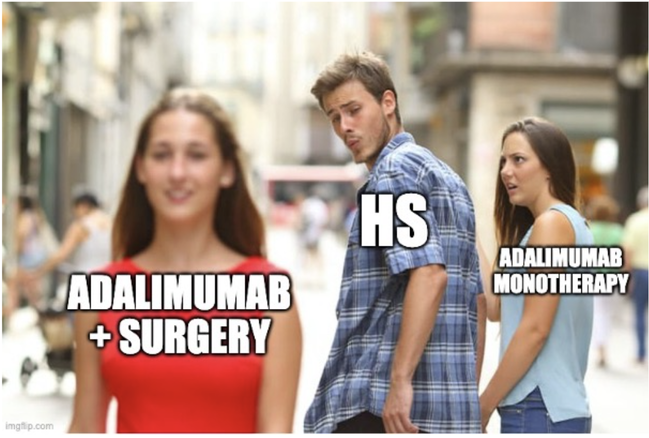Forty-Forth ISSUE
October 4, 2023
Is dupilumab a safe and effective alternative treatment for patients with bullous pemphigoid?
JAMA Dermatology
JAMA Dermatology
Whatever the question…is Dupilumab the answer?
While dupilumab, a biologic IL-4 and IL-13 inhibitor, is approved to treat moderate-to-severe atopic dermatitis, it is also used off-label to treat other dermatologic conditions. This retrospective cohort study evaluated the use of dupilumab for patients with bullous pemphigoid (BP).
What did they find?
Main Takeaway: Dupilumab may be a safe and effective alternative treatment for patients with bullous pemphigoid.
While dupilumab, a biologic IL-4 and IL-13 inhibitor, is approved to treat moderate-to-severe atopic dermatitis, it is also used off-label to treat other dermatologic conditions. This retrospective cohort study evaluated the use of dupilumab for patients with bullous pemphigoid (BP).
What did they find?
- 127 of 146 patients achieved disease control within 4 weeks (defined as absence of new lesions and pruritus, as well as healing of existing lesions)
- 52 (35.6%) of patients achieved complete remission, and 13 (8.9%) relapsed during the observation period
- At 64 weeks, the complete remission and cumulative relapse rates were 62.5% and 30.9%, respectively
- Most common adverse effects (AEs) were infections and eosinophilia
- Patients with serum anti-BP180 antibody levels of at least 50 relative units (OR 3.63; 95% CI, 0.97-12.61; P = 0.045) and female sex may respond better to treatment with dupilumab
Main Takeaway: Dupilumab may be a safe and effective alternative treatment for patients with bullous pemphigoid.
Adalimumab combined with surgery resulted in greater clinical effectiveness and improved quality of life compared to adalimumab monotherapy in patients with hidradenitis suppurativa
Journal of the American Academy of Dermatology
Journal of the American Academy of Dermatology
Adalimumab + Surgery…The Dynamic Duo for HS!
Adalimumab is the only approved biologic for hidradenitis suppurativa (HS), yielding clinical response in 60% of patients. Surgical procedures like deroofing and excision (limited or wide) are often combined with adalimumab; however, their effectiveness when used alongside adalimumab remains unexamined in controlled studies.
This randomized controlled trial (n = 62) aimed to compare the clinical effectiveness of adalimumab combined with surgery versus adalimumab alone in patients with moderate to severe HS. The primary outcome was the difference in International HS Severity Score System reduction after 12 months of treatment.
What did they find?
Main Takeaway: Adalimumab combined with surgery significantly improved clinical response and quality of life compared to adalimumab monotherapy after 12 months in patients with moderate to severe HS.
Adalimumab is the only approved biologic for hidradenitis suppurativa (HS), yielding clinical response in 60% of patients. Surgical procedures like deroofing and excision (limited or wide) are often combined with adalimumab; however, their effectiveness when used alongside adalimumab remains unexamined in controlled studies.
This randomized controlled trial (n = 62) aimed to compare the clinical effectiveness of adalimumab combined with surgery versus adalimumab alone in patients with moderate to severe HS. The primary outcome was the difference in International HS Severity Score System reduction after 12 months of treatment.
What did they find?
- The surgery group demonstrated a significantly greater reduction in International HS Severity Score System compared to the monotherapy group (-19.1 ± 11.3 vs -7.8 ± 11.8; P < 0.001)
- More patients in the surgery group achieved a ≥ 2-point change in Hidradenitis Suppurativa Physician’s Global Assessment Scale (58% vs 18%; P < 0.001)
- There was a greater reduction in draining tunnels in the surgery group compared to the monotherapy group (-4.1 ± 3 vs 1.6 ± 3; P = 0.002)
- No significant difference between groups for mean change in abscess or inflammatory nodule count or percentage of patients achieving HS Clinical Response
Main Takeaway: Adalimumab combined with surgery significantly improved clinical response and quality of life compared to adalimumab monotherapy after 12 months in patients with moderate to severe HS.
Major adverse cardiovascular events in oral janus kinase inhibitor treatment of atopic dermatitis: a systematic review and metaanalysis
British Journal of Dermatology
British Journal of Dermatology
Nothing breaks like a heart...on JAK inhibitors?
The use of JAK inhibitors has exploded in the last decade. In diseases commonly treated with JAK inhibitors, such as inflammatory bowel disease or rheumatoid arthritis, JAK inhibitors may be linked to cardiovascular side effects. However, this association is unclear in patients with atopic dermatitis (AD), a disease without clear cardiovascular burden or comorbidities. '
Researchers performed a meta-analysis to examine the risk of major cardiovascular events in patients with atopic dermatitis receiving JAK inhibitors. They compared two groups over a period of time: one who received at least one dose of a JAK inhibitor for atopic dermatitis (n=9118) and a control group (n=9309).
What did they find?
The use of JAK inhibitors has exploded in the last decade. In diseases commonly treated with JAK inhibitors, such as inflammatory bowel disease or rheumatoid arthritis, JAK inhibitors may be linked to cardiovascular side effects. However, this association is unclear in patients with atopic dermatitis (AD), a disease without clear cardiovascular burden or comorbidities. '
Researchers performed a meta-analysis to examine the risk of major cardiovascular events in patients with atopic dermatitis receiving JAK inhibitors. They compared two groups over a period of time: one who received at least one dose of a JAK inhibitor for atopic dermatitis (n=9118) and a control group (n=9309).
What did they find?
- The control group had 4 primary cardiovascular events (such as stroke, heart attack, cardiovascular related death) and 5 secondary events (including mini strokes/TIA or hemorrhagic stroke) while the JAK inhibitor
- The odds ratio for primary major cardiovascular events in patients treated with JAK inhibitor versus placebo or dupilumab was 1.35 (95% CI 0.15-12.21)
- Given the large confidence interval that encompasses “1”, the risk of major cardiovascular events in patients with AD receiving JAK inhibitors is not significantly increased compared to control.
Does palmoplantar psoriasis prevalence vary between different racial and ethnic pediatric groups?
Pediatric Dermatology
Pediatric Dermatology
Why did the psoriasis go to therapy? Because it wanted to "scale" back its problems!
Psoriasis is a chronic, inflammatory skin disease that causes discomfort and reduced quality of life due to scaling, fissuring, and bleeding of skin lesions. With various manifestations, palmoplantar psoriasis (PP) affects 10-20% of children with psoriasis. There is limited research on PP in children, so researchers conducted a retrospective chart review to investigate PP prevalence and clinical characteristics among different racial and ethnic pediatric groups in (n=330).
What did they find?
Psoriasis is a chronic, inflammatory skin disease that causes discomfort and reduced quality of life due to scaling, fissuring, and bleeding of skin lesions. With various manifestations, palmoplantar psoriasis (PP) affects 10-20% of children with psoriasis. There is limited research on PP in children, so researchers conducted a retrospective chart review to investigate PP prevalence and clinical characteristics among different racial and ethnic pediatric groups in (n=330).
What did they find?
- Black patients were younger (8.2 years +/- 4.4, p=0.001) at their initial dermatology visit compared to other racial groups
- A significantly higher proportion of Black (41.9%) patients were diagnosed with palmoplantar psoriasis (PP) compared to Hispanic/Latino (11.5%) or White (8.9%) patients
- Black patients had more frequent nail involvement (p=0.02), palm involvement (p<0.0001), and sole involvement (p<0.0001) compared to other racial groups, while White patients had a higher prevalence of scalp involvement (p=0.04)
- After adjusting for age and sex, Black patients had a significantly higher chance of having PP than White patients (p<0.0001), with a 6.386-fold increased odds
An innovative technique using chemically-assisted gauze abrasion to de-epithelized vitiligo patches prior to transplantation surgery
Journal of the American Academy of Dermatology
Journal of the American Academy of Dermatology
VitiliGO GO GONE!
Dermabrasion is a resurfacing procedure used in graft surgery or cell-suspension transplantation for patients with vitiligo. The procedure is challenging on large surface areas as it can expose patients to blood-borne pathogens. To avoid dermabrasion, this study investigated outcomes of applying salicylic acid (16.7%) and lactic acid (16.7%) to vitiligo patients 2-3 days before the procedure, hypothesizing that the mixture would improve ease of removal of the epidermis.
How does it work?
Limitation: The collodion paint must be applied evenly and with complete margins of the vitiligo patch borders to allow for complete de-epithelialization of the surgical site– failure to do so leads to skin that did not peel uniformly.
Main Takeaway: The collodion paint creates a less painful and less expensive method for dermabrasion for vitiligo transplant surgery while offering good repigmentation following transplantation.
Dermabrasion is a resurfacing procedure used in graft surgery or cell-suspension transplantation for patients with vitiligo. The procedure is challenging on large surface areas as it can expose patients to blood-borne pathogens. To avoid dermabrasion, this study investigated outcomes of applying salicylic acid (16.7%) and lactic acid (16.7%) to vitiligo patients 2-3 days before the procedure, hypothesizing that the mixture would improve ease of removal of the epidermis.
How does it work?
- Apply the collodion paint 2-3 days before surgery
- On day of transplantation, the site is anesthetized, and the top layer of the epidermis is removed, avoiding the use of dermabrasion in the operating room
Limitation: The collodion paint must be applied evenly and with complete margins of the vitiligo patch borders to allow for complete de-epithelialization of the surgical site– failure to do so leads to skin that did not peel uniformly.
Main Takeaway: The collodion paint creates a less painful and less expensive method for dermabrasion for vitiligo transplant surgery while offering good repigmentation following transplantation.
Dupilumab may be an effective treatment for keloid scarring
Keloid scarring is a condition characterized by excessive fibrous tissue growth following cutaneous injuries, including surgery, burns, and acne. It commonly affects sensitive areas such as the ears, cheeks, and shoulders, posing a challenge due to high recurrence rates and limited treatment efficacy.
Recent research has explored dupilumab, an antibody that inhibits interleukin-4 (IL-4) and interleukin-13 (IL-13) signaling, as a potential therapy for keloids. We present two patient cases: Patient 1, a 23-year-old with extensive keloids from acne, and Patient 2, a 20-year-old with recurrent keloids due to acne. Both patients were initiated on dupilumab treatment.
Main Takeaway: While our cases show promising results, the optimal duration and dosing of dupilumab for keloids remain uncertain. Our cases demonstrate the potential of dupilumab for improvement of keloid symptoms, enhancing the responsiveness of keloids to treatment, and preventing new keloid formation. This approach offers hope for the challenging problem of keloid management and prevention.
Keloid scarring is a condition characterized by excessive fibrous tissue growth following cutaneous injuries, including surgery, burns, and acne. It commonly affects sensitive areas such as the ears, cheeks, and shoulders, posing a challenge due to high recurrence rates and limited treatment efficacy.
Recent research has explored dupilumab, an antibody that inhibits interleukin-4 (IL-4) and interleukin-13 (IL-13) signaling, as a potential therapy for keloids. We present two patient cases: Patient 1, a 23-year-old with extensive keloids from acne, and Patient 2, a 20-year-old with recurrent keloids due to acne. Both patients were initiated on dupilumab treatment.
- Patient 1 – Pain, pruritus, and inflammation of keloids subsided after one-month; noticeable size reduction after three months
- Patient 2 – New acne flares did not result in additional keloids; after two months the patient experienced significant reduction in discomfort and pruritus
Main Takeaway: While our cases show promising results, the optimal duration and dosing of dupilumab for keloids remain uncertain. Our cases demonstrate the potential of dupilumab for improvement of keloid symptoms, enhancing the responsiveness of keloids to treatment, and preventing new keloid formation. This approach offers hope for the challenging problem of keloid management and prevention.






